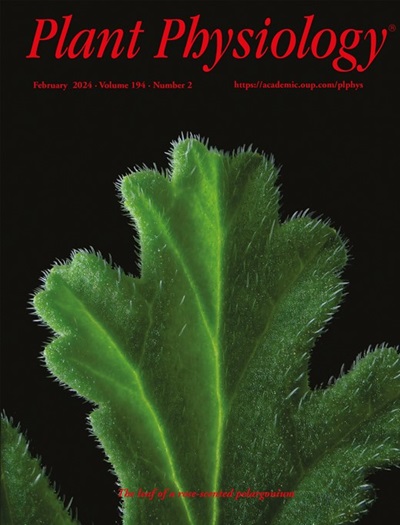Root-derived cytokinin regulates Arabidopsis flowering time through components of the age pathway.
IF 6.5
1区 生物学
Q1 PLANT SCIENCES
引用次数: 0
Abstract
The transition to flowering is governed by different pathways integrating endogenous and exogenous signals. Here, we evaluated the role of the phytohormone cytokinin (CK) in regulating Arabidopsis thaliana flowering time. By analyzing key mutants in CK metabolism, transport and signalling, we found that the hormone promotes flowering under both long-day (LD) and short-day (SD) conditions, with a stronger impact on flowering under SDs. Genetic analyses indicated that both trans- and cis-zeatin regulate the floral transition, while isopentenyladenine plays a minor role. Blocking CK export from roots and reciprocal grafting experiments revealed that root-derived CK is an important flowering signal. Perception and transmission of the CK flowering signal depended on distinct CK receptors, phosphotransmitter proteins and several B-type response regulators. Further, CK functioned through floral integrators such as OVEREXPRESSION OF CONSTANS1 (SOC1) and components of the age pathway. The CK status of plants affected the levels of the age pathway microRNAs miR156 and miR172. Cytokinin-promoted flowering required the miR156-target SQUAMOSA PROMOTER BINDING PROTEIN-LIKE15 (SPL15) and miR172, and the late-flowering phenotype of LD-grown CK-deficient plants depended on miR172-targeted APETALA2 (AP2)-like genes encoding floral repressors. Collectively, this study shows that CK regulates flowering time through the two-component signaling system and components of the age pathway, providing a genetic framework for future investigations.根源性细胞分裂素通过年龄通路的组分调节拟南芥的开花时间。
向开花的过渡是由整合内源和外源信号的不同途径控制的。在这里,我们评估了植物激素细胞分裂素(CK)在调节拟南芥开花时间中的作用。通过分析CK代谢、转运和信号传导的关键突变体,我们发现该激素在长日(LD)和短日(SD)条件下都能促进开花,且短日(SD)条件下对开花的影响更大。遗传分析表明,反式玉米素和顺式玉米素都对花的转变起调控作用,而异戊烯腺嘌呤起次要作用。阻断CK从根输出和反向嫁接实验表明,根源CK是一个重要的开花信号。CK开花信号的感知和传递依赖于不同的CK受体、磷酸化递质蛋白和几种b型反应调节因子。此外,CK通过CONSTANS1的过表达(SOC1)和年龄通路的组分等花整合子发挥作用。植株CK状态影响衰老途径microrna miR156和miR172的表达水平。细胞分裂素促进开花需要靶向mir156的SQUAMOSA PROMOTER BINDING PROTEIN-LIKE15 (SPL15)和miR172,而ld生长的ck缺陷植物的晚花表型依赖于靶向miR172的aptala2 (AP2)样基因编码花抑制因子。总的来说,本研究表明CK通过双组分信号系统和年龄通路的组分调节开花时间,为未来的研究提供了遗传框架。
本文章由计算机程序翻译,如有差异,请以英文原文为准。
求助全文
约1分钟内获得全文
求助全文
来源期刊

Plant Physiology
生物-植物科学
CiteScore
12.20
自引率
5.40%
发文量
535
审稿时长
2.3 months
期刊介绍:
Plant Physiology® is a distinguished and highly respected journal with a rich history dating back to its establishment in 1926. It stands as a leading international publication in the field of plant biology, covering a comprehensive range of topics from the molecular and structural aspects of plant life to systems biology and ecophysiology. Recognized as the most highly cited journal in plant sciences, Plant Physiology® is a testament to its commitment to excellence and the dissemination of groundbreaking research.
As the official publication of the American Society of Plant Biologists, Plant Physiology® upholds rigorous peer-review standards, ensuring that the scientific community receives the highest quality research. The journal releases 12 issues annually, providing a steady stream of new findings and insights to its readership.
 求助内容:
求助内容: 应助结果提醒方式:
应助结果提醒方式:


